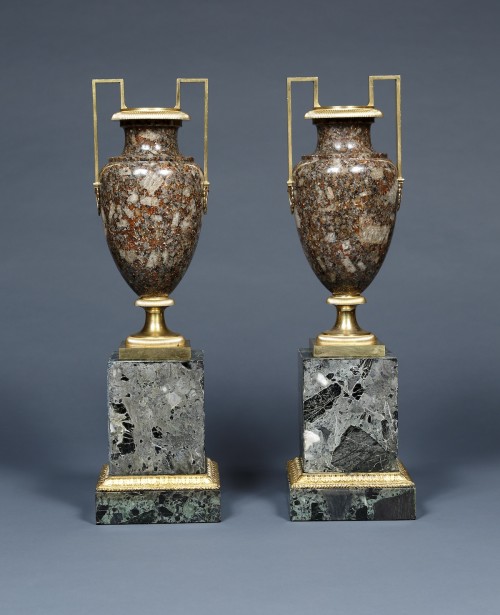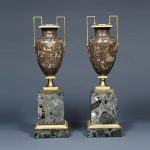11118a A PAIR OF GILT-BRONZE MOUNTED SPECIMEN PORPHYRITIC GRANITE VASES IN THE DIRECTOIRE TASTE Possibly Russian. Early 19th Century. Measurements: Height: 23″ (58 cm) Width: 6″ (15 cm)

Research
Each vase with ovoid porphyritic granite body mounted with angular “handles” emerging from a molded rim. The socle of-gilt bronze resting on a square shallow plinth. The vases resting on verde antico pedestals with gilt foliate border above a stepped base; these bases may not be original, but they are of the same period and have been used together with the vases since at least 1870.
Provenance:
Important old US Collection
The present pair of vases on pedestals was formerly owned by Henry Clay Gibson (1830-1891), where they stood on a mantelpiece in his Philadelphia home (figure 1).
Gibson was a Gilded Age industrialist and whiskey magnate, and the son of John Gibson, a bank accountant and founder of the Gibsonton Mills Distillery near Pittsburgh, Pennsylvania. Henry inherited his father’s successful distillery business at the age of 22, and over the next thirty years he and his partners expanded it significantly. He was also engaged as a financier and banker, and member of various other enterprises throughout Philadelphia such as the Fidelity Insurance, Trust & Safe Deposit Co. and Philadelphia & Reading Railway Co.
In the early 1880s Gibson retired from the firm and focused his attention on assembling his art collection. Although little is known about the way in which he acquired his collection we do know that Gibson had been sent abroad in the mid 1800s to learn more about the family distilling business and he traveled to Italy and France from 1850-52. “He seems to have bought most of his collection on trips to Europe in 1879 and in the 1880s.”1
In the early 1870s Gibson engaged Frank Furness and George Hewitt to incorporate an art gallery into his newly-built townhouse on Walnut Street. Rather than sequester his collection in a single room in the house, Furness & Hewitt devised “ a series of apartments called cabinets, that not only open into each other, but are integral parts of the house itself.”2 Gibson allowed this collection to be open to the public by appointment. He enlisted the services of Furness & Hewitt again in 1881 for his Victorian gothic mansion, Maybrook, which housed his vast collection. It included European furniture and works of art, Chinese porcelain, Cloisonné enamel, European paintings and American sculpture.
Considered one of the wealthiest men in Philadelphia at the time, Gibson’s “greatest and most enduring legacy in the city was his philanthropy and patronage of the arts.”3 He “supported many of Philadelphia’s cultural and scientific organizations, but probably devoted most of his energy to the Pennsylvania Academy of Fine Arts, for which he was a member of the board. Gibson also served on the advisory committee for the American section of the Bureau of Art for the 1876 Centennial Exhibition. Upon his death, Gibson left an estate valued in excess of seven million dollars,4 and bequeathed over 100 works of art from his collection to the Academy of Fine Arts.
Henry Gibson also cultivated a particular interest in natural sciences; his horticultural pursuits were evident in the planning and planting of the grounds and gardens of the Maybrook estate and the appeal of botany was passed on to his granddaughter, who established the Henry Foundation for Botanical research in 1949 in his honor. Gibson was also a generous donor to the Academy of Natural Sciences, giving mineral specimens, marble columns, and funds to support the work of assembling and displaying the first nearly-complete fossilized dinosaur skeleton ever recovered. Gibson’s decorative arts collection reflected his appreciation for geological specimens.
Footnotes:
- Sturges, Hollister. Jules Breton and the French Rural Tradition. Omaha, Neb: Joslyn Art Museum in association with the Arts Publisher, Inc., New York, 1982. 56.
- Lewis, Arnold, James Turner, Steven McQuillin, and George W. Sheldon. The Opulent Interiors of the Gilded Age: All 203 Photographs from “artistic Houses” : with New Text. New York: Dover, 1987. No. 47.
- Property from the renowned collection of Henry C. Gibson and his descendants. Freeman’s, English and Continental Furniture & Decorative Arts. 7 October 2014. Lots 49-59.
- Sturges, 56.





Comments are closed.